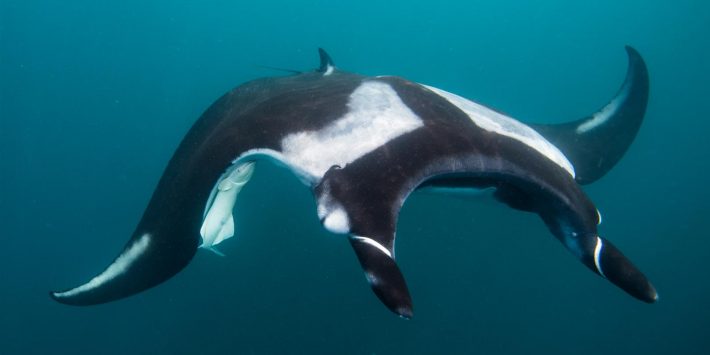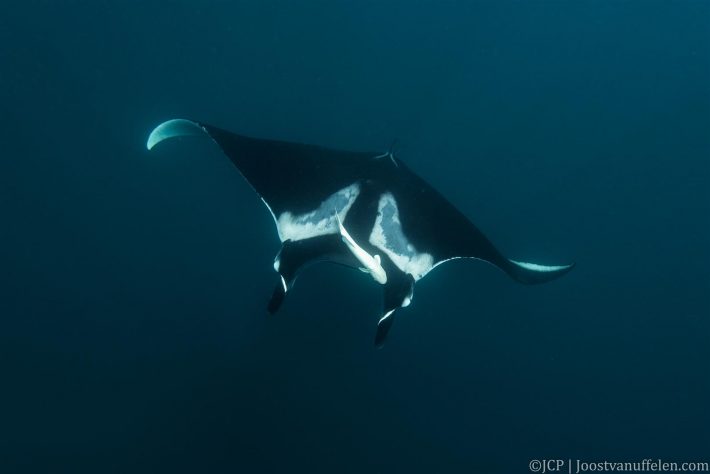Stanford University press release.
Researchers at Stanford University and the Peruvian non-profit Planeta Océano have described the movement patterns and habitat use of giant oceanic manta rays off northern Peru. Their findings are published in Ecological Solutions and Evidence.

The study used satellite telemetry to track the movements of three oceanic mantas from the Tumbes region of northwestern Peru. Electronic tags attached to the mantas recorded their location and diving behavior over a period of several months. These data were transmitted to Earth-orbiting satellites then relayed to the researchers, who were able to reconstruct and analyze the rays' movements.
The oceanic manta ray (Mobula birostris) is the largest ray species in the world, growing up to 7 meters in diameter. These rays were recently classified as Endangered on the IUCN Red List – a comprehensive list featuring the conservation status of the world's biodiversity.
Despite mantas being a popular animal, little is known about their movement patterns along the South American coast. The tag data indicate that mantas move significantly deeper during the night than during the day, a pattern called 'reverse diel vertical migration'. During the daytime, mantas frequently occupied warmer, surface waters (
"We think the mantas may be diving down to feed on zooplankton at night, but as it's so much cooler in these deeper waters, they need to come back up to the surface periodically to rewarm between dives," said Dr. Samantha Andrzejaczek, a Stanford University postdoctoral fellow. Findings could indicate a critical foraging habitat for these animals off Peru and a particular feeding strategy by the mantas here.
"These reverse diel vertical migrations have been found in other shark and ray species, yet to date this behavior had not been described for oceanic manta rays and it is exciting to think how much more we must learn," says Dr Andrzejaczek.
These magnificent animals are important to our marine ecosystems and blue economy.
"Only through research and collaborative efforts with small-scale fishermen, local government and coastal communities will we be able to ensure their conservation," said Kerstin Forsberg from Planeta Océano.
The study also provided new insights into the migratory behavior of the mantas. While two individuals remained around the coast of northern Peru and Ecuador in the weeks following tagging, the third manta moved from the coast of Peru to the coast of Ecuador and from there over 1000 km towards the Galapagos Islands, the longest confirmed migratory track for a manta ray in this study region.

Although further investigation is required to understand why the mantas migrate from place to place, high use of surface waters and migratory movements by the oceanic mantas may put them in danger of entanglement with fishing gear and vessel strikes.
Although mantas have been protected in Peruvian waters since 2016 and in Ecuadorian waters since 2010, they remain vulnerable to bycatch or entanglement. This threat is exacerbated by the large number of small-scale fisheries and gillnets in northern Peru, limited enforcement in international waters, and the species' slow reproductive rate, having one pup each 2-7 years and reaching the age of maturity between 7-10 years. Fishery entanglements with mantas, including pregnant females, are known to occur in northern Peru.
This study emphasizes the critical need to mitigate interactions between endangered manta rays and fishing gear, to ensure efforts to release incidentally captured individuals, and to establish protected areas. It shows the need to further understand the behavior of manta rays and marine biodiversity to ensure the adequate conservation and management of these species.
This study was made possible thanks to Rolex as part of a collaboration between Rolex Awards Laureates Dr. Barbara Block (Stanford University) and Kerstin Forsberg (Planeta Océano), and was additionally supported by the Whitley Fund for Nature, the Bertarelli Foundation, the Moore Foundation, the Nausicaá Charitable Foundation and TAG A Giant.
You can read the research article in full for free here:
Andrzejaczek, S, Schallert, RJ, Forsberg, K, et al. Reverse diel vertical movements of oceanic manta rays off the northern coast of Peru and implications for conservation. Ecol Solut Evidence. 2021; 2:e12051. https://doi.org/10.1002/2688-8319.12051






